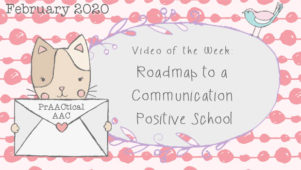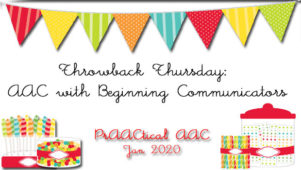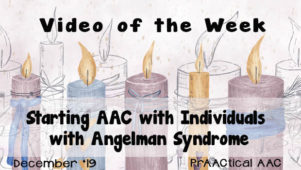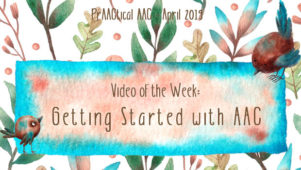Strategy of the Month: Supporting Pre-Intentional Communicators
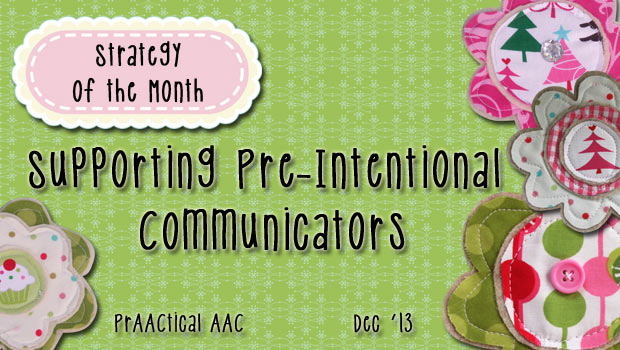
Scene 1
- Alex looks at the picture symbol choices placed in front of him and knocks them to the floor.
- Simone looks distressed while she waits for her lunch and whines as she watches her classmates eating.
- Jason smiles engagingly and rocks enthusiastically when his favorite aide enters the room.
- Kyra takes a picture from her PECS book and begins to chew on it.
Scene 2
- “He can’t even make choices. I’m not even sure what he wants.”
- “She really doesn’t communicate.”
- “He doesn’t mean anything by it. He does that all the time.”
- “She needs hand-over-hand prompting for everything.”
Great kids, caring professionals. Ineffective communication. This month, we focus on ways to support children and adults at the earliest stages of communication. It isn’t easy trying to figure out how to provide effective SLP services to individuals who are not yet sending messages intentionally. Communicators at the pre-intentional level are at-risk of failure. It is hard to include them in meaningful ways in classroom and community activities. Planning instruction is difficult, too. How can we assist these individuals in progressing past the perlocutionary stage, where behaviors are only considered communicative because their partners interpret them as such?
“I’m not sure if he is communicating purposefully. How can I tell?”
Often, professionals observe a behavior, like vocalizing or moving a body part, and can’t really be sure whether it is a purposeful attempt at communication. Hey, if it was clear, we wouldn’t need to write this post, right? Here are some things to think about.
- Does the client make eye contact when demonstrating that behavior?
- Is it something he/she seem to do consistently in certain circumstances?
- Does he/she alternate looking between the communication partner and the object?
- Is he/she persistent and try again if the initial attempts are not satisfied?
- Does he/she seem to modify the behavior in an attempt to be recognized/noticed?
If the answer to one or more of those questions is ‘yes,’ then the client has some intentional communication skills.
“Well, I THINK it is intentional, but I’m not sure.”
If this seems a little hazy, that’s okay. We may never be 100% sure, so our approach is to look for the preponderance of evidence. We observe and try to make reasonable judgements about what we’re seeing. Each time we see a potentially communicative behavior, we stop and ask ourselves: Was that purposeful communication?
Here’s an example.
- Julian looked at his juicebox and vocalized, then looked at his teacher: Score 1 for purposeful communication
- He rocked and vocalized when the music therapist came, but no eye contact: Score 1 for non-intentional
- When SLP offered him a toy, Julian looked at it, looked up at her, then back at the toy and smiled: Another point for purposeful communication
- Julian begins rocking and vocalizing when the music stops. When nothing happens, he gets louder and bangs his hand on the laptray: Purposeful
- Once the music starts, he smiles and moves his head from side to side: Non-intentional
And so on. The point is that we observe the behavior(s) and consider them within the immediate context to help us decide if that behavior is more likely to be ‘probably intentional’ or ‘probably not intentional.’ We’re looking for patterns.
“What if I’m wrong?”
It depends. If you are treating something as intentional, and it is not, don’t worry about it. No problem here. You’re actually doing what you need to do to help that behavior BECOME intentional. On the other hand, if you are treating a behavior as random/non-intentional when it IS actually a true attempt at communication, you’re decreasing the chances that the learner will try again. Not so good.
The take-away message is this: If you’re unsure, treat the behavior AS IF it is a true communication attempt. Doing so increases the chances that the learner will keep at it. And that, of course, is exactly what we want.
“What are some good ways to assess communicators like this and monitor their progress?”
Obviously, these aren’t communicators who can sit across the table from you and complete a battery of tests. For the most part, assessment is observational or informal. Nonetheless, we can gather some very useful data. Here are some ideas.
- Do a frequency count: Keep a running tab of behaviors, as described earlier in this post, categorizing each occurrence in categories of Probably Intentional and Probably Not Intentional.
- Get the team involved: Explain what to look for and how to score/tabulate it.
- Watch a video: Videotape the client and watch it with trusted caregivers. Ask them to alert you whenever they see the client doing something that they interpret as communication. Pause the video to discuss.
- Summarize the results: Use a graph or chart to look for changes over time.
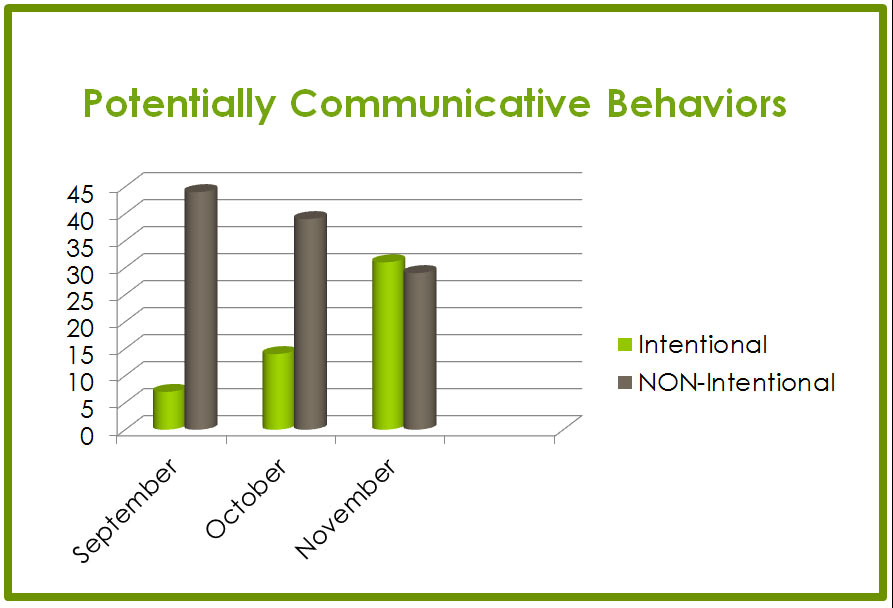
- Communication Matrix: We love this research-based online tool for its ability to give us information about beginning communicators’ overall level of communicative functioning along with information about the purposes for which they communicate and the ways in which they communicate. You can read more about it here.
In future posts, we’ll talk about how to cross the bridge of intentionality and help these communicators become more effective in expressing themselves. In the meantime, if you have any thoughts on working with pre-intentional communicators, we’d love to hear them.
:::::::::::::::::::::::::::::::::::::::::::::::::::::::::::::::::::::::::::::::::::::::
Rowland, C. (2011). Using the Communication Matrix to assess expressive skills in early communicators. Communication Disorders Quarterly, 32, 190-201.
Filed under: Strategy of the Month
Tagged With: beginning communicator, Communication Matrix, perlocutionary stage, preintentional communication
This post was written by Carole Zangari


